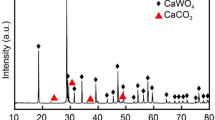Abstract
Zirconium was loaded onto orange waste, a cheap and available agricultural waste in Japan, to investigate the feasibility of its utilization for phosphorus recovery from secondary effluent and side-stream liquid, which contain 5.9 and 68.2 mg/dm3 phosphorus, respectively. The phosphorus removal from side-stream liquid by using zirconium-loaded saponified orange waste (Zr-SOW) gel increased with an increasing solid/liquid ratio, and it was found that Zr-SOW gel showed better performance than zirconium ferrite. The prepared adsorbent was effective for phosphorus removal and exhibited a reasonably high adsorption capacity, twice than that of zirconium ferrite. The secondary effluent was treated in a column packed with Zr-SOW gel, and an dynamic adsorption capacity of 1.3 mol-P/kg was attained. The adsorbed phosphorus from the column was successfully eluted as a concentrated form by using a small amount of 0.2 M NaOH. Throughout the elution process, zirconium was not leaked from the adsorption gel.



Similar content being viewed by others
References
Nowack B, Stone AT (2006) Competitive adsorption of phosphate and phosphonates onto goethite. Water Res 40:2201–2209
Kuroda A, Takiguchi N, Kato J, Ohtake H (2005) Development of technologies to conserve phosphorus resources in response to the phosphate crisis. J Environ Biotechnol 4:87–94 (in Japanese)
Shu L, Schneider P, Jegatheesan V, Johnson J (2006) An economic evaluation of phosphorus recovery as struvite from digester supernatant. Biores Technol 97:2211–2216
European Fertilizer Manufacturers Association (2000) Phosphorus essential element for food production. pp 9–10
Gong G, Ye S, Tian Y, Wang Q, Ni J, Chen Y (2009) Preparation of a new sorbent with hydrated lime and blast furnace slag for phosphorus removal from aqueous solution. J Hazard Mater 166:714–719
Ou E, Zhou J, Mao S, Wang J, Xia F, Min L (2007) Highly efficient removal of phosphate by lanthanum-doped mesoporous SiO2. Colloids Surf A Physicochem Eng Asp 308:47–53
Inoue A, Seike Y, Okumura M (2008) A simple determination of inorganic phosphorous compounds in environmental water based on their collection and separation using zirconium-loaded activated carbon. Bunseki Kagaku 57:599–604 (in Japanese)
Lugo-Lugo V, Hernández-López S, Barrera-Díaz C, Ureña-Núñez F, Bilyeu B (2009) A comparative study of natural, formaldehyde-treated and copolymer-grafted orange peel for Pb(II) adsorption under batch and continuous mode. J Hazard Mater 161:1255–1264
Biswas BK, Inoue K, Ghimire KN, Ohta S, Harada H, Ohto K, Kawakita H (2007) The adsorption of phosphate from an aquatic environment using metal-loaded orange waste. J Colloid Interf Sci 312:214–223
Cotton FA, Wilkinson G, Murillo CA, Bochmann M (1999) Advanced inorganic chemistry, 6th edn. Wiley, Singapore
Perin DD, Dempsy B (1975) Buffers for pH and metal ion control. Chapman & Hall, London
Duenas JF, Alonso JR, Rey AF, Ferrer AS (2003) Characterisation of phosphorous forms in wastewater treatment plants. J Hazard Mater 97:193–205
Medvidović NV, Perić J, Trgo M, Mužek MN (2007) Removal of lead ions by fixed bed of clinoptilolite—the effect of flow rate. Micropor Mesopor Mater 105:298–304
Acknowledgments
This study was conducted with financial support from the Ministry of the Environment, Japan.
Author information
Authors and Affiliations
Corresponding author
Rights and permissions
About this article
Cite this article
Ohura, S., Harada, H., Biswas, B.K. et al. Phosphorus recovery from secondary effluent and side-stream liquid in a sewage treatment plant using zirconium-loaded saponified orange waste. J Mater Cycles Waste Manag 13, 293–297 (2011). https://doi.org/10.1007/s10163-011-0029-6
Received:
Accepted:
Published:
Issue Date:
DOI: https://doi.org/10.1007/s10163-011-0029-6




